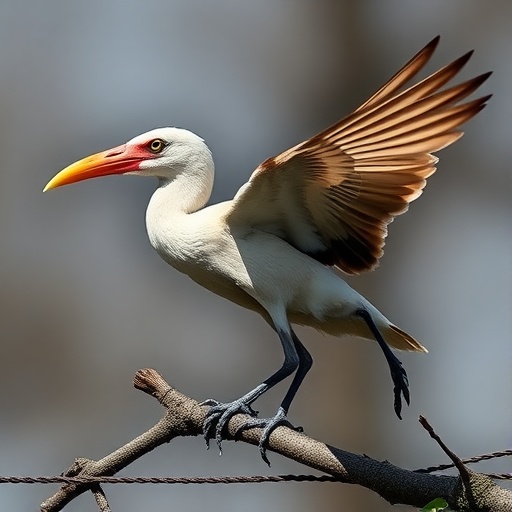Antibiotic-resistant bacteria have emerged as a dire global health threat, primarily studied within hospital environments and human populations. However, groundbreaking research from Brazil now reveals that these formidable pathogens have transcended human boundaries, colonizing wildlife in rehabilitation centers. Researchers supported by the São Paulo Research Foundation (FAPESP) uncovered high-risk multidrug-resistant Escherichia coli (E. coli) clones in wild birds at a rehabilitation center on the coast of São Paulo state, marking a concerning crossover between hospital and nature ecosystems.
In this novel study, multidrug-resistant E. coli clones—previously identified in community and hospital-acquired infections worldwide—were found residing in the intestinal tracts of a barred owl (Strix hylophila) and a vulture. These birds were undergoing care at a rehabilitation center, a facility dedicated to rescuing and rehabilitating wild animals affected by environmental and anthropogenic stressors. The discovery highlights rehabilitation centers as potential hotspots for the interaction and dissemination of antibiotic-resistant bacteria beyond traditional clinical settings.
E. coli is a ubiquitous bacterium inhabiting the gastrointestinal tracts of humans and animals, typically harmless under normal circumstances. The bacteria become pathogenic when they invade sterile sites, such as the bloodstream, urinary tract, or kidneys. In compromised hosts, particularly immune-suppressed individuals, infections caused by multidrug-resistant E. coli often lead to severe illness and increased mortality rates. The alarming presence of these clones in wild birds represents an unforeseen reservoir and vector for spreading resistance genes.
The research underscores the urgent need to establish rigorous protocols for monitoring the microbial flora of animals within rehabilitation centers. Currently, these centers lack standardized, evidence-based procedures to detect, prevent, and manage colonization by antibiotic-resistant microorganisms. Given their role in mitigating human impact on wildlife, rehabilitation facilities must also prevent the inadvertent dissemination of resistant bacteria back into the wild, preserving both animal and public health.
Genomic analyses provided crucial insights into the genetic architecture of resistance in these bacterial clones. Resistance genes are often embedded within mobile genetic elements, such as plasmids and transposons, facilitating horizontal gene transfer across different bacterial strains and species in the environment. This mobility enables resistance determinants to propagate rapidly even in bacteria unexposed to direct antibiotic pressure, exemplifying the pervasive nature of resistance evolution.
One intriguing outcome of this phenomenon is the potential colonization of animals that have never been treated with or exposed to antibiotics, challenging the assumption that resistance is confined to polluted or hospital settings. Continuous environmental surveillance and pathogen monitoring across multiple hosts become paramount to timely detect and curb this silent spread of antimicrobial resistance (AMR).
The wild birds examined in this study were rescued from peri-urban regions—zones characterized by a blend of urban and rural landscapes. This ecological context increases wildlife exposure to anthropogenic contaminants such as sewage, garbage, and chemical pollutants, all of which exert selective pressure favoring resistant bacteria. The rehabilitation center in Santos provided an ideal sentinel environment to sample and assess the extent of AMR dissemination among diverse wild species.
Interestingly, no overt clinical infections were detected in the colonized birds, suggesting asymptomatic carriage of these high-risk clones. The vulture was confirmed to be colonized upon admission and was euthanized shortly thereafter due to severe injuries, eliminating questions about acquisition timing. Contrastingly, the owl had been resident for a decade, undergone multiple antibiotic treatments, and its exact point of bacterial acquisition—whether pre-admission or during rehabilitation—remained ambiguous.
This ambiguity presents a critical challenge for assessing biosecurity risks in wildlife care settings. It raises concerns about whether rehabilitation centers serve as reservoirs facilitating bacterial transmission among animals or from human caretakers. Consequently, more comprehensive studies and vigilance are imperative to dissect these dynamics and develop interventions that minimize the risk of AMR spread.
The researchers advocate for a proactive approach that includes screening animals upon admission to such facilities, isolating colonized individuals, and implementing decolonization therapies when medically warranted. Such strategies could mitigate the risk of releasing resistant bacteria into natural ecosystems, preserving ecological balance and preventing spillover to other wildlife or human populations.
Inspiring initiatives in Brazil, like the Costa Branca Cetacean Project led by the State University of Rio Grande do Norte, exemplify integrated pathogen surveillance in rescued marine species, including attempts to standardize probiotic-mediated decolonization prior to release. These efforts represent promising models for expanding epidemiological surveillance and antibiotic stewardship beyond clinical and agricultural contexts.
Overall, this landmark study illustrates the critical role that wildlife rehabilitation centers can play as sentinels for antibiotic resistance in natural environments. Interdisciplinary collaboration, global mobilization, and increased funding are essential to scale up research and implement robust containment protocols. By embracing One Health perspectives that integrate human, animal, and environmental health, the scientific community can better combat the multifaceted challenge posed by antimicrobial resistance.
This research not only advances our understanding of AMR reservoirs but also warns of the silent ecological circulation of multidrug-resistant pathogens. It calls for heightened awareness and strategic policies that address the complex interplay between human activities, wildlife health, and bacterial evolution. Such vigilance is key to safeguarding future generations from a post-antibiotic era where common infections could once again become lethal.
Subject of Research: Multidrug-resistant Escherichia coli clones in wild birds at rehabilitation centers and their implications for antimicrobial resistance spread.
Article Title: High-risk Escherichia coli global clones ST10 and ST155 in wild raptors admitted to a rehabilitation center
News Publication Date: 1-Jul-2025
Web References:
Study published in Veterinary Research Communications: DOI 10.1007/s11259-025-10811-y
One Health Brazilian Resistance platform: onehealthbr.com
Costa Branca Cetacean Project: pccbuern.org
References:
Sellera, F.P., Lincopan, N., et al. (2025). High-risk Escherichia coli global clones ST10 and ST155 in wild raptors admitted to a rehabilitation center. Veterinary Research Communications. DOI: 10.1007/s11259-025-10811-y.
Image Credits: Tamires Aparecida Serra Lorenzi/UNESP, São Vicente campus
Keywords: Drug resistance, Epidemiology, Public health, Animal diseases, Wild birds
Tags: antibiotic resistance in wildlifeantibiotic-resistant bacteria in natureenvironmental impact on bacteriaEscherichia coli infections in wildlifeglobal health threats from bacteriahuman-animal antibiotic resistance crossovermultidrug-resistant E. coli in birdspathogens in wild birdsrehabilitation centers and antibiotic resistanceSão Paulo wildlife healthsuper-resistant bacteriawildlife rehabilitation and public health





